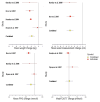Reduction of diabetes risk in routine clinical practice: are physical activity and nutrition interventions feasible and are the outcomes from reference trials replicable? A systematic review and meta-analysis
- PMID: 21029469
- PMCID: PMC2989959
- DOI: 10.1186/1471-2458-10-653
Reduction of diabetes risk in routine clinical practice: are physical activity and nutrition interventions feasible and are the outcomes from reference trials replicable? A systematic review and meta-analysis
Abstract
Background: The clinical effectiveness of intensive lifestyle interventions in preventing or delaying diabetes in people at high risk has been established from randomised trials of structured, intensive interventions conducted in several countries over the past two decades. The challenge is to translate them into routine clinical settings. The objective of this review is to determine whether lifestyle interventions delivered to high-risk adult patients in routine clinical care settings are feasible and effective in achieving reductions in risk factors for diabetes.
Data sources: MEDLINE (PubMed), EMBASE, CINAHL, The Cochrane Library, Google Scholar, and grey literature were searched for English-language articles published from January 1990 to August 2009. The reference lists of all articles collected were checked to ensure that no relevant suitable studies were missed.
Study selection: We included RCTs, before/after evaluations, cohort studies with or without a control group and interrupted time series analyses of lifestyle interventions with the stated aim of diabetes risk reduction or diabetes prevention, conducted in routine clinical settings and delivered by healthcare providers such as family physicians, practice nurses, allied health personnel, or other healthcare staff associated with a health service. Outcomes of interest were weight loss, reduction in waist circumference, improvement of impaired fasting glucose or oral glucose tolerance test (OGTT) results, improvements in fat and fibre intakes, increased level of engagement in physical activity and reduction in diabetes incidence.
Results: Twelve from 41 potentially relevant studies were included in the review. Four studies were suitable for meta-analysis. A significant positive effect of the interventions on weight was reported by all study types. The meta-analysis showed that lifestyle interventions achieved weight and waist circumference reductions after one year. However, no clear effects on biochemical or clinical parameters were observed, possibly due to short follow-up periods or lack of power of the studies meta-analysed. Changes in dietary parameters or physical activity were generally not reported. Most studies assessing feasibility were supportive of implementation of lifestyle interventions in routine clinical care.
Conclusion: Lifestyle interventions for patients at high risk of diabetes, delivered by a variety of healthcare providers in routine clinical settings, are feasible but appear to be of limited clinical benefit one year after intervention. Despite convincing evidence from structured intensive trials, this systematic review showed that translation into routine practice has less effect on diabetes risk reduction.
Figures


References
-
- Norris SL, Zhang X, Avenell A, Gregg E, Schmid CH, Lau J. Cochrane Database of Systematic Reviews. The Cochrane Collaboration; 2005. Long-term non-pharmacological weight loss interventions for adults with prediabetes; p. CD005270. - PubMed
-
- Lindström J, Ilanne-Parikka P, Peltonen M, Aunola S, Eriksson JG, Hemiö K, Hämäläinen H, Härkönen P, Keinänen-Kiukaanniemi S, Laakso M. et al.Sustained reduction in the incidence of type 2 diabetes by lifestyle intervention: follow-up of the Finnish Diabetes Prevention Study. Lancet. 2006;368:1673–1679. doi: 10.1016/S0140-6736(06)69701-8. - DOI - PubMed
Publication types
MeSH terms
LinkOut - more resources
Full Text Sources
Medical
Molecular Biology Databases
Miscellaneous

